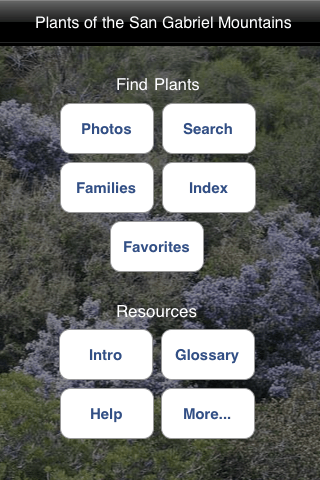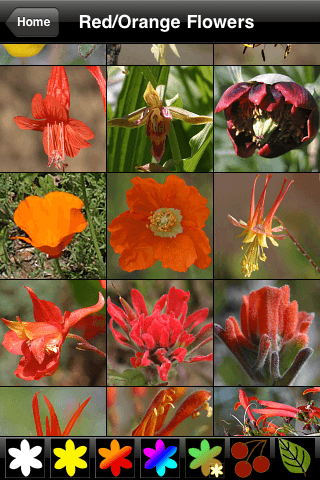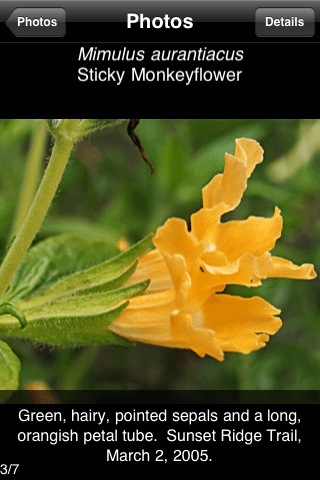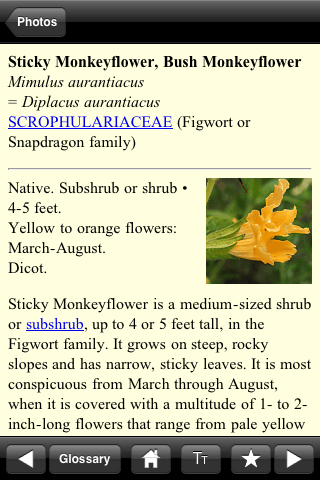After you’ve been hiking for a while, you might start to notice some of your other interests sneaking their way into your trail routines. As a history and geography nerd, I absolutely love poring over topo maps before I hit the trail and comparing my visualizations with the actual trail, and if I come across an old mine or dirt road in the middle of nowhere, there’s a pretty good chance I’ll be doing some research on them when I get home.
Likewise, I’m sure you’ve met your share of “specialized hikers,” be they gearheads, stat-obsessed endurance athletes, survivalists, birders, trackers, or botanists. I dabble in a few of those categories, but I always wish I knew a bit more about the plants lining the hikes I’m on – knowledge’s sake aside, it can be helpful to know which leafy greens will give you rashes and which ones make good tea.
If you’re adverse to hiking with pamphlets or heavy guidebooks, you should check out Earthrover Software‘s SGMPlants App (short for San Gabriel Mountain Plants) on the iPhone. Based on an interactive CDROM created by Cliff and Gabi McLean, It’s an easy-to-use, well-organized and impressive way to learn more about our native plants.
Identify
When you launch the app, you’ll see a simple main screen that shows you just about everything the program can do at a glance:
If you’re looking to identify a plant on the trail, you’ve got a few options at hand. If you know the name of the plant, you can get an alphabetical listing by family or common name. But if you can identify the Latin name of a plant by sight, chances are you probably don’t need this app in the first place. If you’re like me, you can probably identify simpler properties … like color.
Clicking on PHOTOS brings up a series of white flowers:
There are dozens of white blooms on this page, in high-res macro shots. Along the bottom of the screen, you will also note some other identifiers, including several different shades of blooms, including “inconspicuous / green / brown flowers,” as well as different types of fruits and leaves for the less showy members of the plant kingdom.
Touching any thumbnail brings up a full screen photo with a description, as well as several other photos – usually showing the plant in wide shots and without flowers, so you can identify it even if it’s not blooming.
If you wanted to flash back to high school biology, you could also use an identification key-style search function, where drop-down menus let you input the flower color, blooming period, habitat, flower form, number of petals, and more. The App will give you every plant that fits the criteria.
Bookmarking a plant for later reference is a one-touch process, and if all you wanted to use this app for is identifying plants, you’ve got yourself a pretty powerful resource already – but the app offers much, much more.
A Wealth of Information
Touching the “Details” button on any plant bring up an encyclopedic list of further information on that plant, including full descriptions with technical terms, blooming range, habitat, range and related species. The app will also note if the plant is good at attracting wildlife like butterflies or hummingbirds, medicinal uses, the meaning of the name, and even tips for growing it in your own native garden!
So yeah – a TON of information. And in case you were wondering, there is indeed more.
This App also includes a glossary of terms, information on the history and geology of the Angeles National Forest, the differences between the various plant communities in the San Gabriels, information on fires, and basic tips on how to start a native garden on your own. Everything is written in very clear language, and the authors’ enthusiasm and knowledge really shine through in their text. This is a couple who not only knows a lot about what they’re talking about, but they want YOU to know it, too.
Performance
Unless you want to navigate to one of the reference web sites, this app doesn’t require any internet connection. There is also no GPS functionality, so if you’re using this on the trail you don’t have to worry about battery drain. On my 3GS, the pages loaded quickly and everything was very responsive, with only minor pauses when it was loading pages and pages of thumbnails.
Final Word
When the guys at Earthrover emailed me to see if I was interested in reviewing this app, I honestly didn’t know what to expect. I certainly wasn’t expecting a full-fledged encyclopedia of the plant life in the San Gabriels, but that’s exactly what SGMPlants is – and an incredibly impressive one at that.
There are two minor drawbacks to be aware of, though. First, the size. This app features over 1800 full-sized plant photos and 800 thumbnails, covering 258 species. Having all of those high-res plant photos cached on the app itself is going to take up some space on your hard drive – 630MB, to be exact. That’s even more than a few high-res maps on AccuTerra! If you like the idea of having so much information at your fingertips, you may have to clear out some space on your device before loading this app.
I have to assume that all of the photos have already been optimized for space, and I’d hate to see the developers lose photos to save a few megabytes. I like that this app shows me what poison oak looks like without its leaves in the winter – it just means I’m probably going to take it off of my iPhone until the morning I head out for a hike.
The other thing that may turn some people off is the price – currently $12.99 in the App Store. With the iPad and its new HD apps, we may be approaching the era of routinely priced $10-20 apps, but for someone who’s used to dropping mostly $1-2 at a time in the App Store, thirteen bucks can be a bit off-putting. However, you really are buying a full-fledged field guide with this app – and it’s certainly lighter and easier to use than a guide in book form, which would probably be around the same price.
While this is not a must-have app for all hikers, it’s definitely worth checking out even if you have just a passing interest in our native flora. There’s enough to justify the price in here for novice petal-peepers and experts alike, as well as for anyone who’s trying to plant a native garden. And it’s here just in time for wildflower season!
*note – Earthrover also features similar apps that cover the Santa Monica Mountains, Death Valley, Sierra Nevada, and other areas. Check out more of their field guides here. The other field guides are all priced at $9.99.
Tags: botany, Earthrover Software, iphone app, product review, San Gabriel Mountains Plants, wildflowers








